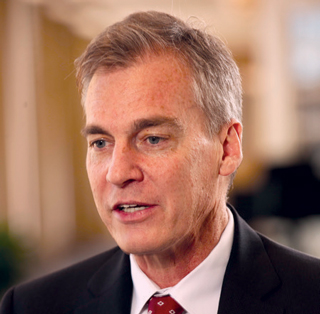
The nation’s most influential nursing home leader says the White House’s goal of imposing first-ever minimum staffing levels could work — but only under certain conditions.
They include supplying more funding, considering local workforces in calculations and making waivers available. Providers said waivers have been vital for complying with the federal healthcare worker COVID-19 vaccination mandate.
“If [the Centers for Medicare & Medicaid Services] is going to actually issue a requirement, they have to be thoughtful about when it kicks in based upon the availability of workforce,” said American Health Care Association / National Center for Assisted Living President and CEO Mark Parkinson. “They need to make sure it’s funded, and they need to provide waivers for buildings and markets where workers just aren’t available.

“If all those things are done, it’s possible to do this in a responsible way that helps residents, as opposed to putting their care at risk,” he told McKnight’s Long-Term Care News in an interview Thursday. “But if it’s done in a very simple way which is, ‘You have to have a 4.1 [average nursing hours per patient per day] and if you don’t, we’re going to fine you or close you,’ hundreds of thousands of residents will be living in buildings that are at risk of closure.”
Parkinson warned that 94% of U.S. nursing homes currently do not supply 4.1 hours of nursing care per patient day. Nursing care is the combination of direct care time supplied by registered nurses, licensed practical nurses and certified nursing assistants. The 4.1 minimum figure grew out of past studies and is bandied about as an unofficial baseline, though states now have widely varying requirements typically well below that level.
In late February, the administration announced it intended to study how a minimum staffing mandate could be put in place by March of 2023. The topic has been one of skilled nursing’s most hotly debated issues since and figures to only intensify in the months ahead.
Parkinson and other industry leaders are hopeful, based on their successful lobbying for the pay rule. It wound up giving providers a much sought-after two-year phase in of payment rate recalibrations plus a higher-than-expected pay rate.
“We’re grateful for the payment rule. We really appreciate CMS phasing the parity adjustment and think it’s an important part of us getting to a recovery,” Parkinson said. “And we’re really pleased with how it happened. Providers spoke up about the challenges they faced with the cut. There were 6,920 unique comments. We did orchestrate a campaign, but it wasn’t form letters. It was encouraging people to send individual comments. I’m really not sure CMS has ever received that many unique comments on any topic.”
‘Lights-out’ threat for many providers?
The annual pay-rate battle, however, could pale in comparison to the expected campaign around mandated staffing levels. Nursing homes have lost 230,000 employees since the start of the pandemic, worsening previous staffing shortages and making providers incredulous at the thought of “minimum” rules dictating higher staff levels.
“We’re spending a large part of our time now working on the postponement of the staffing rule because a horribly conceived, unfunded 4.1 mandate could be lights-out for many buildings in the sector. The workers aren’t there to comply, and the funding isn’t there to pay for it,” Parkinson explained.
He believes the key will be educating CMS on “the lack of workers and the cost of paying for the workers we do have.”
A federal contractor is amid a two-month period of interviews with all levels of staff in select long-term care facilities to learn more about considerations for any mandate. Parkinson hopes for a “reasonable” policy.
“We worked with CMS on the vaccination mandate and it developed a waiver that has worked for most providers. We need that same sort of thoughtfulness to go into development of any minimum staffing rule,” he said. “We’re encouraged that CMS is listening. We have been submitting ideas as to what proposals should look like.
“We’re encouraged they have a process in place,” he added. “We’re just concerned that at the end of the day — because this is such a complex issue — folks might be tempted to throw up their hands and just say, ‘Let’s do an unfunded 4.1 mandate and let the sector figure it out.’ That just won’t work. The workers aren’t there and the money isn’t there. It would cost $10 billion a year to fund that.”
The health of the industry is largely contingent on recovering census as well as staff. The former is doing better than the latter, Parkinson said.
“Unfortunately, we’ve had almost no recovery in our workforce,” he observed. “If you look at the Bureau of Labor Statistics data, we hit a low point of losing 240,000 workers. We gained around 3,000 workers last month. That’s just slightly over 1% of what we lost. I am hopeful we hit the bottom a few months ago and now we’re slowly creeping back and getting workers.”
He said positive signs include more foreign nurses finally trickling back into the labor stream.
“We’ve been working with the State Department. Nurses who were in the queue to come to the U.S. are starting to show up,” he said. “I would say things are slightly better on the labor side but it still has a long way to go.”
Other promising indicators are more domestic job applicants are showing up and “almost every” provider is developing ways to reduce the use of contract nurses “and some have been quite successful with it.”
Average wage inflation of 9.5% over the last year has been good for workers but not for operators, he noted.
“The problem with inflation, whether it’s Medicare at the federal level or Medicaid at the state level, these increased costs tend to really lag these increased costs, so it takes a while for these costs reports to show these expenses,” he explained. “Operators right now are dealing with record-high labor costs and a still-challenging census picture and it’s not good. I just can’t conceive of these wages coming down.”




